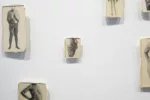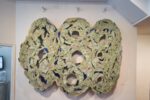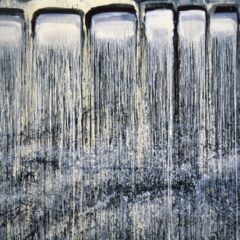
James B. Abbott, Provincetown Moors, toned gelatin silver print, 15.5″ x 19.5″
The message dominates the medium in the exhibit at the Print Center of the 80th Annual International Competition for Photography. And since content is what interests me most, I was quite engrossed while looking at the array of work from 35 artists, a mix of familiar local names as well as unfamiliar ones from across the country.
Bits of the world that we don’t normally study closely is one of the big themes in the show–from local photographer James B. Abbott’s sexy closeup shot, Provincetown Moors, which won the big purchase award for the Print Center Permanent Collection at the Philadelphia Art Museum to Megan Elise‘s untitled C-print of the corner of a white room, sparsely adorned only by only three objects–a cross, a pull-for-help cord, and some indecipherable medical bulb or plastic bag. This is my life and death pairing. Some of the other unexpected views included tiretracks, a pile of mulch, and a shimmering red curtain by local photographer John Lorenzini, which is the best piece I’ve seen from him. Someone else liked it too, because it won one of the 13 smaller awards given out this year.
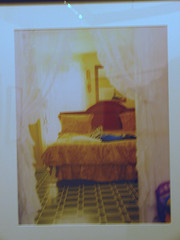
Sonando, by Lupita Murillo Tinnen, C-print, 20 x 16 inches
Rooms were another theme, and two different ones I especially enjoyed were Robin Radin’s Boston State Hospital, Abandoned #2 gelatin silver print for it’s fine attention to textures and light; and Lupita Murillo Tinnen, from Plano, Texas, for Sonando.
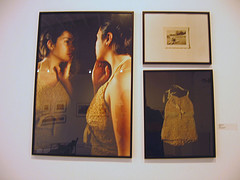
Rosario, by Margarida Correia, C-print, 30 x 36 inches
The portraits each had some unexpected wrinkle. I loved Brooklynite Margarida Correia’s portrait suite, “Rosario,” which includes four views of the subject–a portrait of Rosario and her reflection in a mirror, a portrait of her outfit, and a little old black-and-white snapshot of her as a child, with her mom (I presume) on the beach). Local photographer Peter Miraglia’s portrait, Parameswaran (shown below), sizzles with color and with hot oily skin. The injured eye is the slowest piece of information to communicate, after all that heat registers. And Deana Lawson’s Bruce Family, which includes one blurred child who cannot stay in line, is a portrait of a family and a room that communicate dizzying self-control, restraint and class-consciousness.
There were lots more things I liked. The low, flattening perspective of Ellie Brown’s Under the Hairdryer, and the low perspective on carpeting in Sparky Campanella’s 475 Brannan Street, both of them inkjet prints. The show catalog states that 70 percent of the works in the show have a digital component and 43 percent of the images were made with inkjet printers, both records reflecting the massive switch to digital in the field.
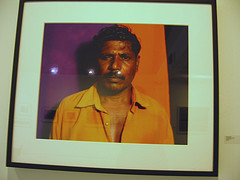
Parameswaran, by Peter Miraglia, digital C-print, 18 x 23 inches
In terms of image presentation, the work was pretty traditional–rectangles on the wall, shot directly with a camera. Not that I’m knocking it. Some of the other ways photos get presented can be pretty tortured. The show was curated by Stephen C. Pinson, the curator of the New York Public Library’s photographs, and the photos are nicely hung, talk to their neighbors, and all in all gave me plenty to think about as I looked and admired. The show mainly nibbles at the trends, and offers lots of quiet pleasures.
I’m sorry to report (and you can verify here in these pages) that I took the world’s worst photos of this show. To see a few more of them, (I even weeded out the worst of my efforts) go here. Sorry.


